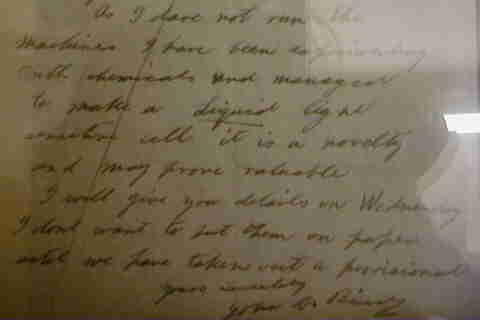Hastings Museum has vital Baird Letters!! - see below
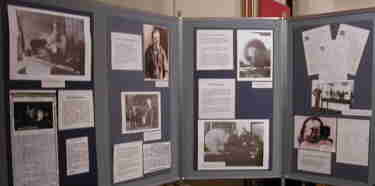
Right Part of the Baird Exhibition in Hastings Museum
Baird appears to have arrived in Hastings in the winter of 1922 following an unsuccessful business venture in the Caribbean making jam and a more successful enterprise selling soap which appeared to be just about to take off when he fell ill and was advised to leave London. He came to Hastings to join his old Glasgow school friend, Guy Robertson, known as 'Mephy', with whom he had shared lodgings in London the previous year. Mephy was then living at 21 Linton Crescent and this is where Baird joined him.
Baird had already experimented with the idea of television at school and at college began to really apply himself to the possibility in earnest. Apparently, he was inspired to begin his experiments again on a long walk over the cliffs to Fairlight Glen.  Cutting from The Times, 27th June 1923 |
During the spring of 1923, Baird seems to have developed his apparatus with the help of Mephy at Linton Crescent to the extent that, on 27 June, he put an advert in The Times, 'Seeing by wireless. Inventor of apparatus wishes to hear from someone who will assist, not financially, in making working model'. As a result of this, the editor of 'Broadcasting' magazine and the Chief Research Engineer at the BBC came down to Hastings to visit him and, subsequently, sent down some equipment. He was also contacted by a London cinema owner, Will Day, and, together, they entered a partnership and applied for Baird's first patent for a system of transmitting views, portraits and 'Scenes by telegraphy or wireless telegraphy' on 26 July 1923.In November 1923, an account of his experiments in Hastings appeared in Chamber's Journal. It seems that, by late 1923, Baird had succeeded in transmitting shadowy images although the receiver and transmitter were still mechanically connected.
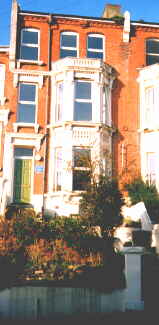 |
 |
|
The House at 21 Linton Crescent, December 1998 |
|
In January 1924, Baird made a public demonstration of his apparatus - the image transmitted was that of a Maltese cross - and representatives from the national paper, the Daily News and also the Hastings Observer were present. Photographs of Baird in his Hastings workshop were reproduced in both papers.
Although it is clearly stated that this demonstration took place at 21 Linton Crescent, it does appear that Baird had a workshop elsewhere in the town earlier in 1923. According to the Observer, this was 'a laboratory near Hastings Station' which he was forced to relinquish when it became needed for a shop. It has not yet been identified where this was. In March 1924, Baird was able to transmit between separate machines.
By April 1924, Baird had moved his workshop out of his lodgings in Linton Crescent and moved to the upper floor of No 8 Queen's Avenue. He was able to do this because his father, John Baird, the retired Presbyterian Minister of West Parish Church, Helensburgh read in the national press of his demonstration and sent a £50 donation.


Baird's early Experiments at Queens Arcade, Hastings
In April 1924, several accounts of Baird's experiments appear in various broadcasting journals including the Radio Times and he was asked to lecture to the newly formed Hastings, St Leonards & District Radio Society. Several members of this society were closely involved with Baird and experiments in Hastings in 1923 and 1924.
In April, there also appeared in the national press an account of the first ever television broadcast by Baird from Hastings. This could only of course be received on radios and apparently was identified by a 'curious high pitched whistle'. The first official television transmission was made in August 1926 when Baird obtained the first television licence from the Post Office.
In July 1924, Baird had a bad accident in Queen's Arcade as a result of a short circuit. He was hurled across the length of his workshop by a 1200 volt shock and found lying stunned on the floor with burnt hands and damaged apparatus. As a result of this he was asked by his landlord, Mr Tree, to vacate the premises. After some argument - including a rather public scene outside on the pavement Baird did eventually leave in August 1924 and returned to London.
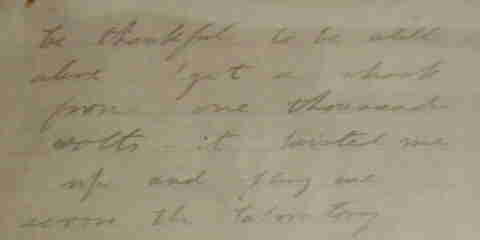 Part of Baird's letter to Will Day 25/7/24, from Linton Crescent ".. thankful to be still alive, I got a shock from one thousand volts - it twited me up and flung me across the laboratory" courtesy Hastings Museum |
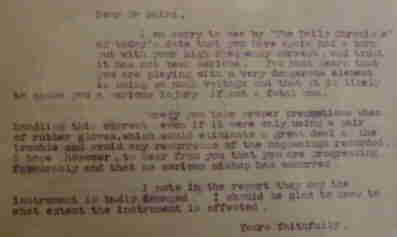 A news item in the "Daily Chronicle" apprised Day of what had happened even before he received Baird's letter, Day's response dated 25th July 1924 included "I note in the report they say the instrument is badly damaged. I should be glad to know to what extent the instrument is affected" courtesy Hastings Museum |
|
|
|
Baird returned to Hastings in 1927 at the invitation of Victor Mills of the Hastings & District Radio Society to lecture at the White Rock Pavilion. By this time, his work was more nationally known after a demonstration at Selfridges in March 1925 and to the Royal Institution in January 1926. Over this period, he progressed from the image of a flickering Maltese cross to a ventriloquist's dummy to an actual human face.
The White Rock lecture formed part of a four day exhibition on "The Wonders of Science" which was held between October 5th and 8th. The display in the "Wireless & Signalling section" included a replica of the televisor made by Baird in Hastings four years previously and regular demonstrations were given during the exhibition.
The lecture was well attended and enthusiastically received. Baird told the audience, "I have many pleasant memories of Hastings. I owe a lot to your air and sunshine". He went on to describe how by projecting images onto a photo-electric cell, currents were produced which turned the image into sound. This could then be transmitted and picked up on a wireless receiver.
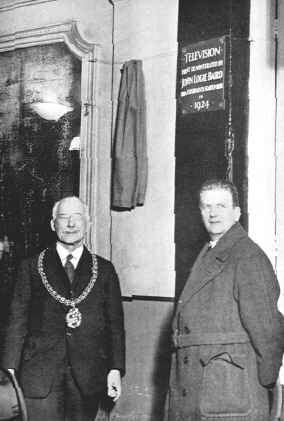
7th November 1929, Mayor of Hastings (Cllr. Thorpe) unveils Commemorative plaque with J L Baird in Queens Arcade, Hastings |
To illustrate the point he played a number of gramophone records of the sound waves created by the image of a dummy's head. Similar 78 rpm records made by Baird have recently been converted into flickering pictures for the first time by Don McLean, some of whose work can be seen in the Museum of Photography, Film & Television at Bradford. By using this technique Baird was recording some of the first video images, although at the time he was unable to play them back.
Baird also talked about his experiments with Noctovision. In order to overcome the need for strong light in transmitting an image he had been experimenting with infra red rays. This opened up the possibility of a device that could be used by sailors in foggy weather, in other words radar.
In 1929, Hastings was the first town to honour his achievement with the mounting of a plaque in Queen's Avenue - a ceremony at which Baird himself was present.
In February 1940, Baird's wife, the South African pianist Margaret Albu was due to give a performance at the White Rock Pavilion. Former Theatre Manager, John Burton, remembers that at the last minute the recital was cancelled as she was taken ill.
Finally in early 1945, Baird came back to Sussex and lived at Bexhill at No 1 Station Road where sadly, he died in 1946 - apparently the house has always been bad for television reception.
* Baird's original apparatus which he used at Hastings was apparently made using a cardboard disc cut from a hat box, another disc of tin plate cut out with scissors, some lenses from bicycle lamps, sealing wax and darning needles for spindles and was powered by a small electric fan motor. He was helped in this by schoolboy, Norman Loxdale, who was sent to the Maypole Grocers in Castle Hill Road to buy tea chests to make the discs whilst the bicycle lamps came from Wheelers in the Arcade.
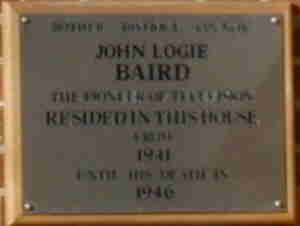 |
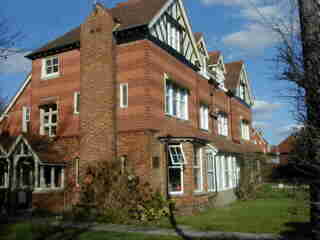 |
|
In 1941 until his death in 1946 Baird lived in this house by the station in Bexhill-on-sea, a small town a few miles to the west of Hastings. Apparently television reception in this house has never been good!.The house was demolished and has been replaced with a block of flats "Baird Court" |
|
Baird was also helped by local radio shop owner, Victor Mills, who seems to have made several key adjustments to Baird's apparatus as well as offering important advice. Mills also recounted in the 1970s how the first transmitted image was actually his fingers.
Baird gave his original television apparatus to the South Kensington Science Museum in 1926.
At Christies Auction on 20th October 1999 Hastings Museum successfully bid for letters written by John Logie Baird in 1924 and are particularly significant because they are the only letters written by JLB that relate directly to television . The bid was supported by the Science Museum, and, ironically, the Went Tree Trust established by Baird's former landlord!. These letters written from 21 Linton Crescent, to Will Day, Baird's financial backer at the time, and Day's (not always sympathetic) replies are now on show in Hastings Museum.
Links
World's earliest TV recordings - Don McLean
Have a look at the OLD
visitors book
![]()
![]()
![]()
![]()
![]()
![]()
011109 040118 050122 071018 080710 081015 111217 140403
